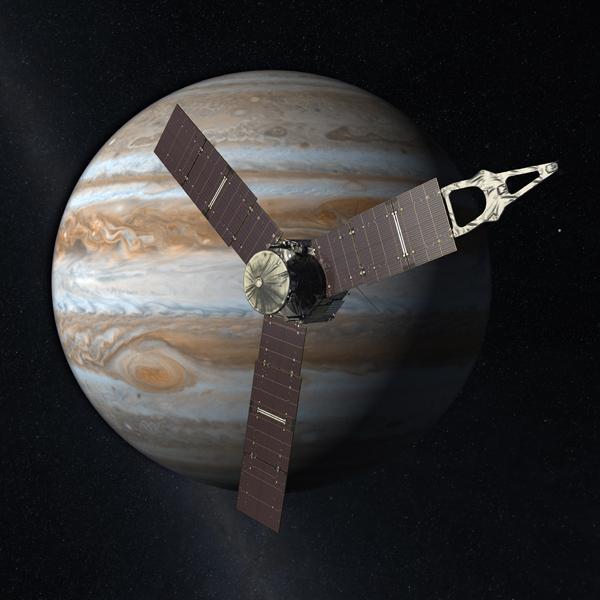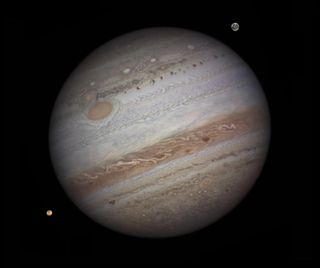
A NASA spacecraft now has Jupiter more squarely in its sights ahead of its July 4 arrival at the solar system's largest planet.
NASA's solar-powered Juno probe performed an engine burn Wednesday (Feb. 3), consuming 1.3 pounds (0.6 kilograms) of fuel to change its speed by about 0.7 mph (1.1 km/h). Juno was roughly 51 million miles (82 million kilometers) from Jupiter when it conducted the maneuver, agency officials said.
"This is the first of two trajectory adjustments that fine-tune Juno's orbit around the sun, perfecting our rendezvous with Jupiter on July 4 at 8:18 p.m. PDT [11:18 p.m. EDT; 0318 GMT on July 5]," Juno principal investigator Scott Bolton, of the Southwest Research Institute in San Antonio, said in a statement.
The second of these engine burns is scheduled to take place on May 31, NASA officials said.
The $1.1 billion Juno mission launched in August 2011. Its main goal involves mapping Jupiter's gravitational and magnetic fields in precise detail, to help scientists learn about the gas giant's structure, formation and evolution, mission team members have said.
Juno will perform its science work from orbit. The nominal mission plan calls for the 4-ton spacecraft to zip around Jupiter 33 times, coming within just 3,100 miles (5,000 km) of the planet's cloud tops once every 14 days, NASA officials said.

Juno carries three 30-foot-long (9 m) solar panels, which together hold a total of 18,698 individual solar cells. Such extensive light-collecting gear is necessary to power the spacecraft in the relatively dim environment around Jupiter, which orbits more than five times farther from the sun than Earth does.
Get the Space.com Newsletter
Breaking space news, the latest updates on rocket launches, skywatching events and more!
Last month, Juno became the farthest-flung solared-powered probe in spaceflight history. The previous record was held by the European Space Agency's comet-chasing Rosetta spacecraft, which got a maximum of 492 million miles (792 million km) from Earth in October 2012.
Follow Mike Wall on Twitter @michaeldwall and Google+. Follow us @Spacedotcom, Facebook or Google+. Originally published on Space.com.
Join our Space Forums to keep talking space on the latest missions, night sky and more! And if you have a news tip, correction or comment, let us know at: community@space.com.

Michael Wall is a Senior Space Writer with Space.com and joined the team in 2010. He primarily covers exoplanets, spaceflight and military space, but has been known to dabble in the space art beat. His book about the search for alien life, "Out There," was published on Nov. 13, 2018. Before becoming a science writer, Michael worked as a herpetologist and wildlife biologist. He has a Ph.D. in evolutionary biology from the University of Sydney, Australia, a bachelor's degree from the University of Arizona, and a graduate certificate in science writing from the University of California, Santa Cruz. To find out what his latest project is, you can follow Michael on Twitter.